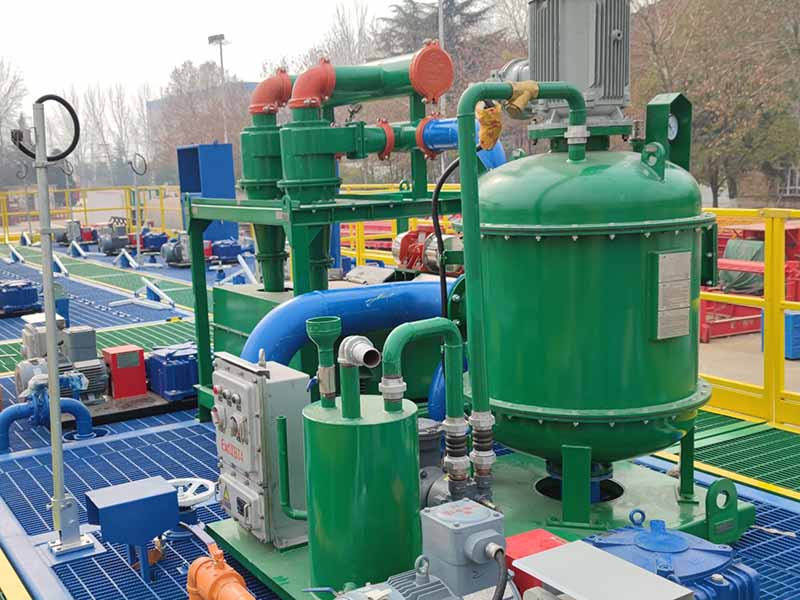What is a Solids Control System Vacuum Degasser?
May 16, 2025
The solids control system vacuum degasser is a critical component of the petroleum drilling fluid solids control system, primarily designed to remove harmful gases such as natural gas and hydrogen sulfide (including free and dissolved gases invaded during formation drilling) from drilling fluid (mud). It prevents well blowout risks caused by reduced mud density due to high gas content while restoring mud properties to ensure the safety and efficiency of drilling operations.
Ⅰ. Working Principle
1.Creation of Vacuum Environment
As a vacuum-type degasser, it uses a vacuum pump to generate a negative pressure environment (below atmospheric pressure) inside the degasser’s vacuum tank.
2.Atomization and Degassing of Drilling Fluid
Gas-invaded drilling fluid enters the vacuum tank through the inlet and is atomized into fine droplets via nozzles or distributors.
Under negative pressure, gases (e.g., methane, hydrogen sulfide) in the droplets rapidly escape, achieving gas-liquid separation.
3.Gas-Liquid Separation and Discharge
Separated gases are extracted by the vacuum pump and safely discharged through exhaust pipelines (connectable to combustion units for treatment if necessary).
Degassed drilling fluid returns to the solids control system from the bottom outlet of the tank for continuous recycling.
Ⅱ. Main Structure and Components
Vacuum Tank:The main container with a negative pressure environment, equipped with internal atomization devices (e.g., nozzles, cyclones).
Vacuum Pump:Provides vacuum power, commonly using water-ring or rotary vane vacuum pumps.
Gas-Liquid Separator:Further separates trace liquids carried by discharged gases to prevent fluid from entering the vacuum pump.
Control System:Monitors parameters such as vacuum pressure and liquid level, automatically adjusting operating conditions.
Inlet and Outlet Pipelines:Connect to the drilling fluid circulation system for input of gas-invaded fluid and output of degassed fluid.
Ⅲ. Functions and Application Scenarios
Core Functions
Efficiently removes ≥90% of free gases from drilling fluid, reducing gas invasion risks.
Maintains stable mud density and rheological properties, minimizing mud waste.
Collaborates with other solids control equipment (e.g., shale shakers, desanders, desilters) to complete the mud purification process.
Application Scenarios
Oil and gas drilling operations, particularly in gas-bearing formations (e.g., shale gas, high-sulfur formations).
Integration into solids control systems on offshore drilling platforms and onshore drilling sites.
Ⅳ. Technical Features and Selection Criteria
Technical Features
High processing efficiency: Adaptable to varying drilling fluid flow rates.
Adjustable vacuum pressure: Typically maintained at -0.04 to -0.08 MPa, flexible for different gas contents.
Explosion-proof design: Motors and control systems meet explosion-proof standards for flammable environments.
Selection Criteria
Processing capacity: Matched to drilling fluid circulation flow rate (e.g., a 200 m³/h rig requires a correspondingly capable degasser).
Vacuum pressure requirements: Higher vacuum for gas-rich formations to ensure degassing efficiency.
Installation type: Skid-mounted (mobile) or integrated (combined with other solids control equipment).
Energy consumption and maintenance: Prioritize low-energy, easy-maintenance models (e.g., non-dismantling cleaning design).
Ⅴ. Equipment Positioning and Core Value
The vacuum degasser is one of the core components of petroleum and natural gas drilling solids control systems, specializing in addressing mud gas invasion. Its core value includes:
Safety Assurance: Efficiently removes flammable and explosive gases (natural gas, hydrogen sulfide) from mud, avoiding major accidents like blowouts and explosions caused by gas accumulation.
Cost Optimization: Restores mud density and rheology, reducing mud waste and cutting re-mixing costs (saving ~10%-20% of mud costs per well).
Efficiency Enhancement: Maintains stable mud properties, ensuring drilling speed and reducing non-productive time (e.g., downtime due to gas invasion).
Ⅵ. Maintenance Key Points and Fault Troubleshooting
Daily Maintenance
Vacuum pump: Replace lubricating oil every 500 hours.
Atomization device: Inspect nozzle blockage weekly and clean with high-pressure water (use a nozzle cleaning tool with diameter ≤0.3mm).
Sealing system: Test airtightness of tank flanges and pipeline interfaces monthly (leakage rate <0.5%/h).
Common Faults and Solutions
Insufficient vacuum pressure: Caused by pump wear or system leaks. Replace impellers/seals and check for leaks with soapy water.
Reduced degassing efficiency: Due to clogged nozzles or high liquid level. Clean nozzles and adjust the inlet valve to maintain liquid level at 2/3 of tank height.
Abnormal vibration: Caused by misaligned motor couplings or loose foundation bolts. Re-align couplings and tighten bolts (to ≥90% of specified torque).
Liquid carryover in discharged gas: Due to failed gas-liquid separators or low vacuum pressure. Replace separation components and increase vacuum to ≥-0.06MPa.
Ⅶ. Collaboration with Other Solids Control Equipment
The vacuum degasser typically works with the following equipment to form a complete mud purification process:
Shale shaker: First-stage treatment to separate >74μm drill cuttings, reducing solid load on the degasser.
Desander/desilter: Processes 20-74μm particles to minimize wear on subsequent centrifuges.
Mud Centrifugal Pump: Separates <20μm ultra-fine particles and recovers valuable solids like barite.
Mud tanks: Store degassed mud and provide buffer volume (typically 4-6 tanks).
Through full-process collaboration, mud sand content can be controlled below 0.5% and gas content below 1%, meeting the requirements of high-complexity drilling operations.
Read More





 Language :
Language : English
English Русский
Русский عربي
عربي
 GET A QUOTE
GET A QUOTE



 IPv6 network supported
IPv6 network supported